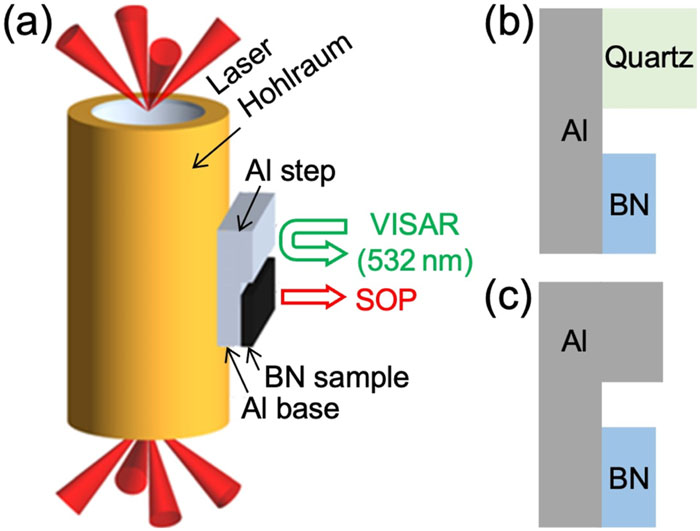Huan Zhang, Yutong Yang, Weimin Yang, Zanyang Guan, Xiaoxi Duan, Mengsheng Yang, Yonggang Liu, Jingxiang Shen, Katarzyna Batani, Diluka Singappuli, Ke Lan, Yongsheng Li, Wenyi Huo, Hao Liu, Yulong Li, Dong Yang, Sanwei Li, Zhebin Wang, Jiamin Yang, Zongqing Zhao, Weiyan Zhang, Liang Sun, Wei Kang, Dimitri Batani. Equation of state for boron nitride along the principal Hugoniot to 16 Mbar[J]. Matter and Radiation at Extremes, 2024, 9(5): 057403
Search by keywords or author
- Matter and Radiation at Extremes
- Vol. 9, Issue 5, 057403 (2024)

Fig. 1. (a) Schematic of experimental configuration. The planar sample package is attached to the side of the hohlraum. Two types of sample packages were used. (b) The first type consists of an Al pusher plate, the BN sample, and the quartz standard to measure the in situ shock velocity profile. (c) The second type uses an Al step instead of the quartz standard.

Fig. 2. Experimental configurations and typical data from the shots. The surface reflection and thermal emission signals were recorded by VISAR and SOP, for the Al base, BN sample, and quartz/Al-step standards. (a) Schematic of Al–BN–quartz-type EoS target. (b) Time-resolved VISAR and (c) SOP data for shot 043 using this type of target. t 1 marks the time when the shock crosses the interface between Al and BN, and t 2 marks the shock breakout time from the rear surface of the BN sample. After t 1, the shock propagates in the transparent quartz standard, with its shock front being monitored by VISAR. (d) Schematic of the Al–BN–Al-type target. (e) VISAR and (f) SOP data for shot 047. Three times are measured: t 1 is the time when the shock enters the BN sample, and t 2 and t 3 are the shock breakout times from the BN sample and the Al step, respectively. Since the our BN sample is porous, gradually increasing thermal emission ahead of shock breakout can be observed for BN, as shown in (c) and (f).
Fig. 3. Theoretical calculations of BN EoS at high pressures using the DFT-MD method, compared with previous results. (a) Principal Hugoniot calculated with three different choices of initial energy density E 0 with initial density 2.08 g/cm3. The Hugoniot with E 0 = −38.44 Ry/formula-unit best matches the previous experimental results (empty circles). (b) BN phase diagram in the pressure range relevant to this study. The best-match Hugoniot crosses the solid–liquid boundary at ∼1 Mbar pressure. The melting curve for c-BN (solid red) agrees well with the previous theoretical result (dashed green).
Fig. 4. Analysis of VISAR and SOP data for the Al–BN–quartz target in shot 043. The upper panel shows time-resolved SOP counts in the Al base, BN sample, and quartz standard. t 1 and t 2 are the shock breakout times from the rear surface of the Al base and BN sample, respectively. t 1 was determined as the half-height time of the rising edge of the SOP signals, while t 2 was determined as the half-height time of the corresponding dropping edge. The shock transit time through the BN sample is Δt BN = t 2 − t 1. The lower panel shows the shock velocity profiles in the quartz standard, extracted from the two VISAR legs. The average quartz shock velocity calculated between t 1 and t 2 is used in the IM analysis.
Fig. 5. IM analysis in the pressure vs particle velocity plane for a typical shot using the Al–BN–quartz target (shot 046). The state of the quartz in this shot is determined by the intersection of the Hugoniot curve with the measured quartz Rayleigh line [plot (1)]. The Al release line going through this point is then determined. The intersections with the standard Al Hugoniot and the measured BN Rayleigh line determine the states of Al and BN along the respective Hugoniot [plot (2)]. Uncertainty ranges are shown by the dashed lines. The main source of errors in the IM analysis comes from the shock velocity measurements.
Fig. 6. Time-resolved X-ray radiation temperatures measured in the shots, illustrating the reproducibility of the X-ray drive. The unsteady-shock corrections calculated for the Al–BN–quartz shots 044 and 048 (solid lines) can be used in the Al–BN–Al shots 047 and 050 (dotted lines), respectively.
Fig. 7. Data analysis for the Al–BN–Al target in shot 047. The time-resolved VISAR and SOP counts in the Al base, BN, and Al are plotted. t 1, t 2, and t 3 are the shock breakout times from the Al base, the BN, and the Al step, respectively. These times were determined as the half-height positions of the corresponding rising/dropping slopes. The shock transit times in the BN and Al step were calculated as Δt BN = t 2 − t 1 and Δt Al = t 3 − t 1.
Fig. 8. Comparisons of theoretical BN Hugoniots with shock experiments. The data are presented in (a) the U s –u p plane and (b) the pressure–compression plane. For the theoretical curves, our DFT-MD Hugoniots for h-BN were calculated for the initial density 2.04 g/cm3 (solid black) and the initial density 2.08 g/cm3 (solid purple). The Hugoniot for c-BN (solid green) from Zhang et al. 23 was calculated starting from ρ 0 = 3.45 g/cm3 with model X2152. The experimental data for h-BN obtained in this study are shown in red. Our measurements and DFT-MD simulations are highly consistent up to 16 Mbar. As a comparison, the shock Hugoniot data for c-BN from previous experiments23 and for h-BN from RUSBANK15,16 are also shown.
|
Table 1. Shock Hugoniot data obtained from the Al–BN–quartz targets.
|
Table 2. Shock Hugoniot data obtained from the Al–BN–Al target.

Set citation alerts for the article
Please enter your email address



